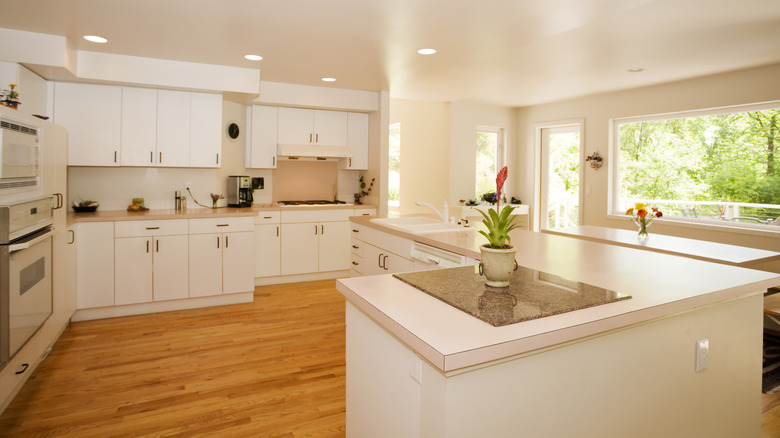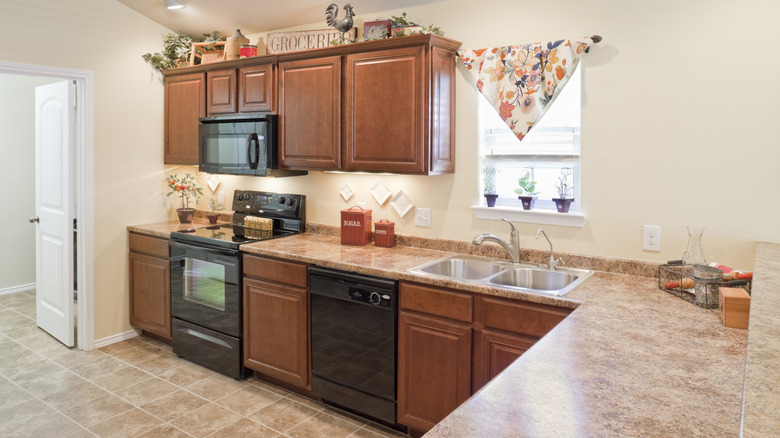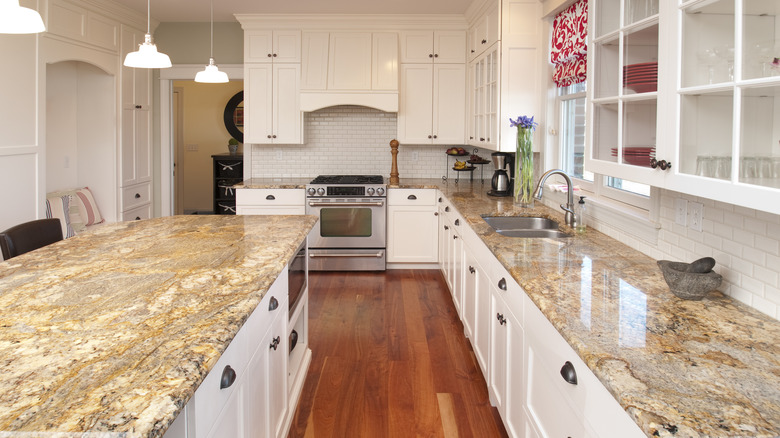The Difference Between Formica And Laminate Countertops (And Which Is Right For You)
When you watch home improvement or house hunting shows on channels like HGTV, it's common to see designers and homeowners discussing and comparing countertop materials like granite, butcher block, and quartz. If you've ever bought or remodeled a house in real life (on a real budget), however, you may have found yourself wondering about the difference between more inexpensive options such as Formica and laminate. You might also be surprised to find out that the two are actually the same material.
A laminate countertop is created by layering paper and resin on top of particleboard. Formica is simply the most popular brand of laminate countertop on the market. Therefore, it has become synonymous with the term, much like facial tissue is frequently referred to as Kleenex, regardless of brand. This expands the question from what the difference is between laminate and Formica to whether or not laminate countertops will meet your home's needs and if Formica is a brand worth paying more for.
Formica vs generic laminate countertops: appearance and quality
Laminate countertops are a very popular alternative to costly natural stone options like granite or marble. Thanks to technological advancements, it is now possible to purchase laminate countertops that quite convincingly mimic the appearance of high-quality stone or even wood materials. Basically, in this day and age, no one has to know that your laminate countertops aren't actually marble, granite, or quartz — unless you want them to. However, not all brands are created equal. When it comes to custom or high-quality imaging, Formica is well-known for outperforming other brands. When it comes to performance, however, it may be a bit more difficult for any brand of laminate to compare to higher-quality materials.
Unlike stone countertops, laminate countertops aren't scratch, water, or high-heat resistant. While granite can tolerate brief exposure of up to 1,200 degrees Fahrenheit, laminate — including Formica — is limited to brief exposure to a mere 275 degrees Fahrenheit — well under the temperature of most pans when removed from your stove or oven. The biggest threat to laminate, perhaps, is water. It is not uncommon for exposure to water to cause delamination, which occurs when the outer layer of a laminate material begins to peel away from the other inner layers. A name-brand laminate like Formica may hold up better to scratches, heat, and water than a generic brand, but it won't hold a candle to stone. However, with care, it is possible to extend the life of your laminate countertops.
Formica vs generic laminate countertops: cost
Laminate countertops might not be as durable as natural or manmade stone materials, but their prices are enticing enough for many homeowners to take the risk. On average, a generic-brand laminate countertop costs about $10-40 per square foot. Formica laminate comes in at an average of $20-60 per square foot. Granite or marble countertops, in comparison, cost an average of $40-100 per square foot. Quartz countertops will set you back an average of $70-100 per square foot and stylish butcher block countertops average about $50-150 per square foot.
Once you become familiar with the cost of various countertop material options, it becomes obvious why so many homeowners choose laminate despite its lower quality. Depending on the brands chosen and the prices paid, you could potentially install a kitchen full of laminate countertops and eventually replace them for the price of one kitchen full of granite, marble, quartz, or butcher block countertops. In the end, the countertops you choose should be the ones that fit comfortably within your budget. For many, that may mean settling on Formica, which will cost slightly more than generic laminate but also offer a bit more durability and customization options.


